
For further information, please contact Professor Mark Brisbane- mbrisbane@bournemouth.ac.uk
The closing date for this post is Wednesday 2 September 2015.
Latest research and knowledge exchange news at Bournemouth University

For further information, please contact Professor Mark Brisbane- mbrisbane@bournemouth.ac.uk
The closing date for this post is Wednesday 2 September 2015.
BU’s Paola Palma will be introducing us to a world of shipwrecks and shipworms at the next Talk BU Live event on Tuesday 24 February. Join us in Dylan’s Bar at 5:30pm for a fascinating insight into maritime archaeology and the secrets beneath the sea.
About the talk
Marine borers, particularly shipworms – destroyers of timber par excellence – have been a well-known threat to sailors since ancient times. They attacked the wooden hulls of ships with such intensity that the weakened planks broke up even with mild impact such as hitting a rock or a floating object, causing tragic ship-wrecks. Even the survival of sunken ships as historic wrecks depends on the mercy of wood-destroying organisms, which may turn these “port-holes” to history into meaningless junk.
Recent research along the English coast has shown evidence of a shipworm which is typical of much warmer waters. But what exactly are these sea-dwelling critters? Why are they so far north? And what can we do to stop them destroying our maritime history?
About Talk BU Live
Talk BU Live is a once monthly on-campus event designed to get people talking and thinking. Talks are no more than 20 minutes long with a short Q&A at the end and are open to all students and staff at BU.
You can get involved by tweeting #TalkBU or find out more by contacting the team below or visiting the Talk BU page on the BU website.
Please note that this event will be video recorded and made available online.
Contact
Tel: +44 (0) 1202 961041
Email: newsdesk@bournemouth.ac.uk
Web: www.bournemouth.ac.uk/talk-bu
Last Thursday and Saturday 11th and 13th December, Festival of Learning on Tour went to Bournemouth’s Christmas market to showcase some fantastic research activities, based on the work of BU’s academics. The response from members of the public was extremely positive and many seemed keen to attend future events at the 2015 Festival of Learning (11-17 July)
Some of the activities showcased to the members of the public included James Gavin’s Exercise Science at Home, involving a handgrip strength task which tested upper body strength and the sit and stand test which tested lower body strength. Dr Kevin McGhee senior lecturer in Health Sciences was also there with PHD student Rosa-Spencer Tansley to talk to people about the basics of DNA.
Researcher Tom Cousins and PHD student Orestes Manousos brought along some artefacts from marine archaeology dives, carried out to find artefacts of wrecks from WW1 and WW2 which included a cannon!
While these amazing research activities were a great way to engage members of the public with the Festival of Learning, there was also some time for a very special friend of ours to make an appearance, yes, wait for it………….Professor Puzzles, the Festival of Learning’s best friend made an appearance at the Christmas markets and absolutely wowed members of the public with some of his smooth dance moves and gave them photos which they will remember for a long time. We have decided to spoil you by uploading some of the photos from Professor Puzzles walk around the Christmas markets below.
With the huge success of the Christmas markets, the Festival of Learning on Tour will return again in the summer, for more details about this, email Naomi Kay on nkay@bournemouth.ac.uk
Don’t forget that the deadline to submit an event for the Festival of Learning 2015 is 12 noon on Friday 19th December, fast approaching, so don’t miss out on the opportunity to be a part of the Festival, click here if you would like to submit an event.

Professor Puzzles at the market!

Professor Puzzles showing of some smooth moves!
On the 26th November, Nerve Radio hosted a new research feature on their news discussion show to open student’s eyes to some of the fantastic work that goes on behind the lecture halls and seminar rooms.
This was a fascinating half hour where researcher Tom Cousins talked about some his current projects. Maritime Archaeology was the topic of discussion on the 26th and Tom gave a very interesting overview of his day-to-day activities on this truly fascinating subject area that I’m sure had a lot of students envying those studying on the maritime archaeology course.
Some of the discussion focused on dives that he and a team participated in looking for artifacts and tanks of WW1 and WW2 wrecks. The main project was the Swash Channel Wreck, which Tom was involved in as a student back in ‘07-’09.
Another major project discussed on the Nerve Radio research feature is a study of the Salcombe Kingsbridge Estuary which was used as the maritime equivalent of the Big Dig. This involved intertidal surveys and excavations, and this summer Tom excavated a World War 2 Motor Torpedo Boat.
If this is a topic that you would like to hear more about please email tcousins@gmail.com
After this successful Nerve Radio research feature, we can expect more to come in the New Year, so if you are planning on listening in next time, email ssquelch@bournemouth.ac.uk and I can keep you up to date with the dates and type of researcher that will be featuring on Nerve.
Google Under-the-Earth: Seeing Beneath Stonehenge is the first application of its kind to transport users around a virtual prehistoric landscape, exploring the magnificent and internationally important monument, Stonehenge.
The application was developed by Bournemouth University archaeologists, using new field data gathered during their work with colleagues from the universities of Sheffield, Manchester, Bristol, Southampton and London as part of the Stonehenge Riverside Project. Google Under-the-Earth works by adding layers of archaeological information to Google Earth technology.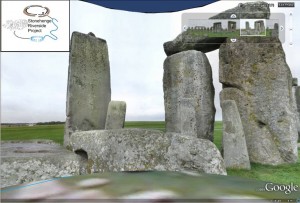
The unique visual experience lets users interact with the past like never before. Highlights include taking a visit to the Neolithic village of Durrington Walls, a trip inside a prehistoric house and the opportunity to see reconstructions of Bluestonehenge at the end of the Stonehenge Avenue and of the great timber monument called the Southern Circle, as they would have looked more than four thousand years ago.
The project is funded by the Arts and Humanities Research Council (AHRC) and Google Research Awards, a program which fosters relationships between Google and the academic world as Google fulfils its mission to ‘organize the world’s information and make it universally accessible and useful.’
But this fabulous educational and cultural tool does not end with Stonehenge. Archaeological scientist Dr Kate Welham, project leader at Bournemouth University, explained that it is the start of something much bigger.
“It is envisaged that Google Under-the-Earth: Seeing Beneath Stonehenge could be the start of a new layer in Google Earth. Many of the world’s great archaeological sites could be added, incorporating details of centuries’ worth of excavations as well as technical data from geophysical and remote sensing surveys in the last 20 years,” she said.
Dr Nick Snashall, National Trust Archaeologist for Stonehenge and Avebury World Heritage Site, said: “The National Trust cares for over 2000 acres of the Stonehenge Landscape. Seeing Beneath Stonehenge offers exciting and innovative ways for people to explore that landscape. It will allow people across the globe, many of whom may never otherwise have the chance to visit the sites, to share in the thrill of the discoveries made by the Stonehenge Riverside team and to appreciate the remarkable achievements of the people who built and used the monuments.”
You can download the application from the Google Under-the-Earth: Seeing Beneath Stonehenge site. The tool is easy to use and requires Google Earth to be installed on your computer.
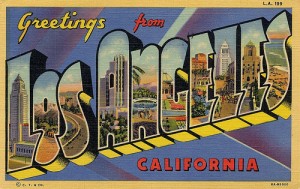 Today is my first day back in the office after a road trip from Vancouver to Los Angeles, taking in many exciting cities, national parks, activities, etc en route. From spotting killer whales in the San Juan Islands to making the most of tax free shopping in Portland to hydrobiking in Long Beach harbour, I’ve packed in lots of fun! One of the coolest things we did, however, was to go to the La Brea Tar Pits at the Page Museum in Los Angeles.
Today is my first day back in the office after a road trip from Vancouver to Los Angeles, taking in many exciting cities, national parks, activities, etc en route. From spotting killer whales in the San Juan Islands to making the most of tax free shopping in Portland to hydrobiking in Long Beach harbour, I’ve packed in lots of fun! One of the coolest things we did, however, was to go to the La Brea Tar Pits at the Page Museum in Los Angeles.
 The La Brea Tar Pits is one of the world’s most famous fossil localities, recognized for having the largest and most diverse assemblage of extinct Ice Age plants and animals in the world. Whilst I was walking around the museum looking at skeletons of giant sloths and sabretooth tigers, a fossilised mammoth tooth (the size of my head) and a display of 404 dire wolf skulls, I had a eureka! moment. The museum is an excellence example of transparent research that engages the public and results in huge societal impact.
The La Brea Tar Pits is one of the world’s most famous fossil localities, recognized for having the largest and most diverse assemblage of extinct Ice Age plants and animals in the world. Whilst I was walking around the museum looking at skeletons of giant sloths and sabretooth tigers, a fossilised mammoth tooth (the size of my head) and a display of 404 dire wolf skulls, I had a eureka! moment. The museum is an excellence example of transparent research that engages the public and results in huge societal impact.
The entire research lifecycle is onsite and visible to visitors, including information on:

Through windows at the Page Museum Laboratory, visitors can watch bones being cleaned and repaired. Visitors can also visit Pit 91 and see a tar pit being excavated.

The Museum periodically canvasses visitor opinions and surveys changes in public understanding to ensure that research impact is being maximised and to justify the public funding that makes the research possible.
Evidently this integration of engagement, access to research and demonstrable societal impact is easier in some disciplines than others but research shouldn’t be taking place behind closed doors in universities; members of the public should be involved throughout the research lifecycle. This is a key strategy of Research Councils UK (RCUK) and other major funding bodies (such as Defra and the Royal Society). You can access the Concordat on Engaging the Public with Research here.
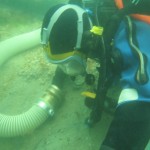 Dave Parham and Paola Palma (School of Applied Sciences) have been researching the Swash Channel Wreck which lies in approximately 7m of water in the Swash Channel in the approaches to Poole Harbour. The site was discovered as a side-scan sonar anomaly as a result of a geophysical survey conducted by Wessex Archaeology on behalf of Poole Harbour Commissioners and Poole Borough Council. The site has since been designated as a Historic Wreck.
Dave Parham and Paola Palma (School of Applied Sciences) have been researching the Swash Channel Wreck which lies in approximately 7m of water in the Swash Channel in the approaches to Poole Harbour. The site was discovered as a side-scan sonar anomaly as a result of a geophysical survey conducted by Wessex Archaeology on behalf of Poole Harbour Commissioners and Poole Borough Council. The site has since been designated as a Historic Wreck.
 The ship is the subject of a major excavation by BU, supported by English Heritage. It has been dated to around 1630 and includes the earliest ship carvings ever found in the UK, including a mysterious wooden merman, and much of the evidence found on the wreck suggest that it would have been a relatively high status ship for its period.
The ship is the subject of a major excavation by BU, supported by English Heritage. It has been dated to around 1630 and includes the earliest ship carvings ever found in the UK, including a mysterious wooden merman, and much of the evidence found on the wreck suggest that it would have been a relatively high status ship for its period.
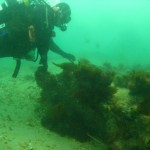 The wreck has been featured on the One Show (6 April 2011) where presenter Dan Snow took part in a dive on the wreck in the mouth of Poole Bay alongside a team of BU Marine Archaeologists, led by Dave.
The wreck has been featured on the One Show (6 April 2011) where presenter Dan Snow took part in a dive on the wreck in the mouth of Poole Bay alongside a team of BU Marine Archaeologists, led by Dave.
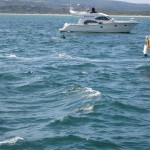 Dave will also feature in the fourth episode of Britain’s Secret Seas, The Bustling South, on 29 May at 8pm on BBC2.
Dave will also feature in the fourth episode of Britain’s Secret Seas, The Bustling South, on 29 May at 8pm on BBC2.
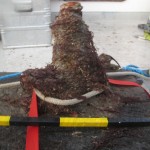 After conservation, finds from the Wreck and all the information from the excavation will be passed on to Poole Museum Service to be displayed to the community.
After conservation, finds from the Wreck and all the information from the excavation will be passed on to Poole Museum Service to be displayed to the community.